Ö8 Artist: Isabelle Andriessen
Interviewed by Yuän (ÖÖÖ)
#
ÖÖÖ:
Your sculptures appear like future-prehistoric exoskeletal machinery. Evident substances such as crystals, coolants, and plastics still crawl, move, and drip, undergoing transformation and connecting with hoses and conduits in their metabolism. These artworks often invite interpretations as future fossils or ruins, or as resilient materials adapted to evolve in disrupted and toxic environments.
To me, they also evoke the imagination of scenarios involving technological artifacts from absent extraterrestrial beings. It is as if the sculptures embody a new form of technology, merging mechanics and biology, possibly with origins rooted in Earth’s relics — yet, their purpose remains undefined—whether for production, medical, spacecraft components, or something else.
As the creator, what landscapes do you envision your artwork depicting?
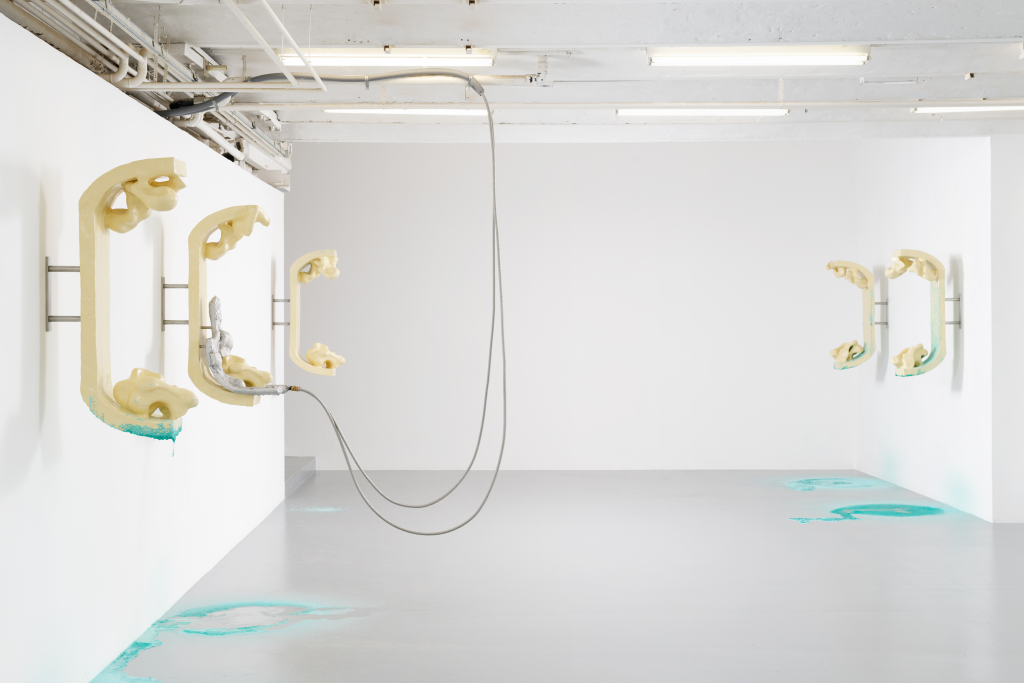
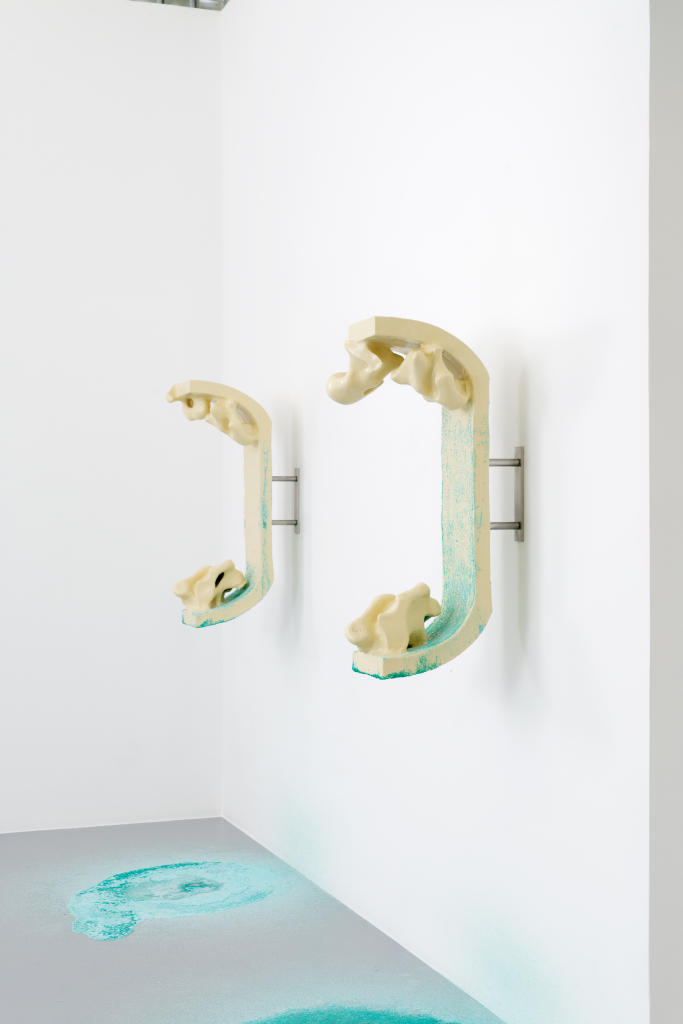
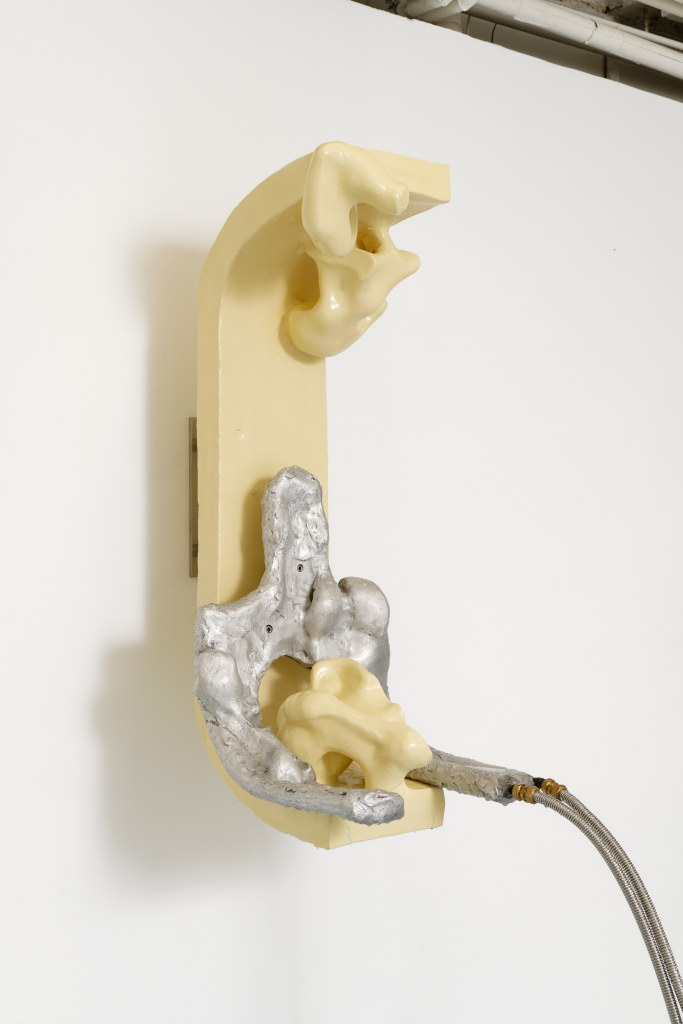
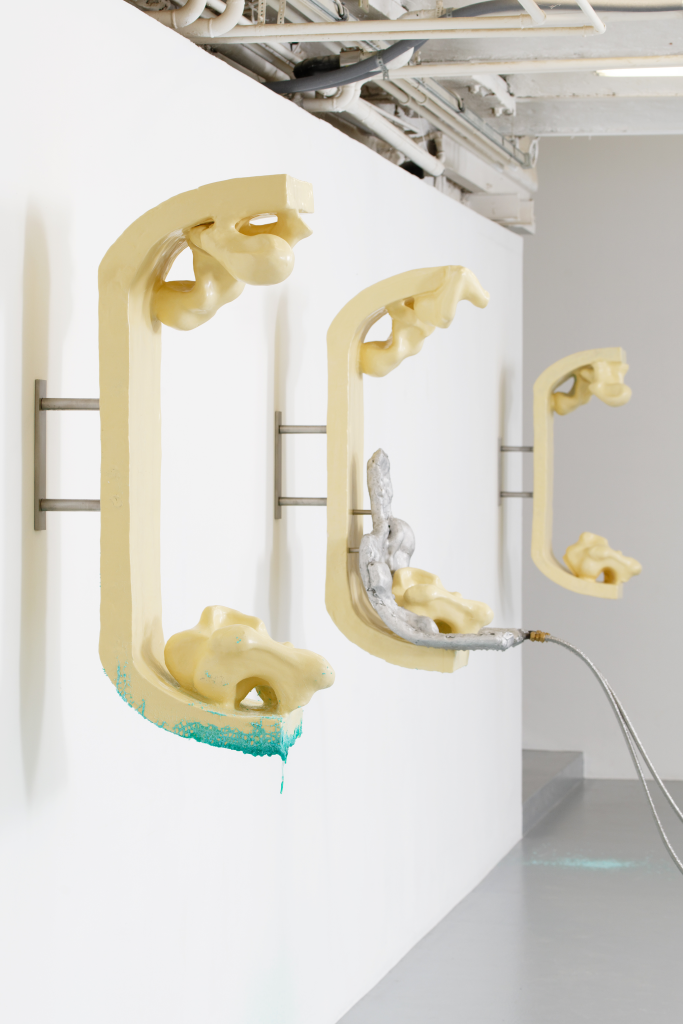
Ceramics, aluminum, epoxy, nickel sulphate, stainless steel, water cooler, pump. 120 cm x 40 cm x 60 cm each
Photo credits: Aurélien Mole. Courtesy: the artist and CAN Centre d’Art Neuchâtel
Isabelle Andriessen:
My works intend to channel a speculative landscape resonating with burning e-waste sites, oil spills, deserted mines, landfill and abandoned shipyards – the ruins of war, capitalism and colonialism. In this seemingly imaginative landscape shows a toxic ecology created by human taking its own turn and agency. A landscape in which toxins ooze, leak and melt, feeding and fueling other entities with some violent and vital force – resulting in uncanny mutations. A landscape that at first glance might seem like from a science-fiction film or faraway future, yet these sculptures derive from landscapes that are actually existing in reality. The fact that these accumulating sites are out of sight for the majority of the Western part of the world or capitalized countries, might make it seem like they are fictional, but the resources I build and compose these installations from are all existing sites.
#
ÖÖÖ:
There appears to be subtle emergence from invisibility in your artwork, manifesting traces on the entities of new organ flows. During observation, the human perspective dissolves ghostly into space, becoming part of invisible hyper-objects, gazing at the remnants of their demise and the emergence of new life.
The manifestation of time is likely related to what you’ve consistently investigated.
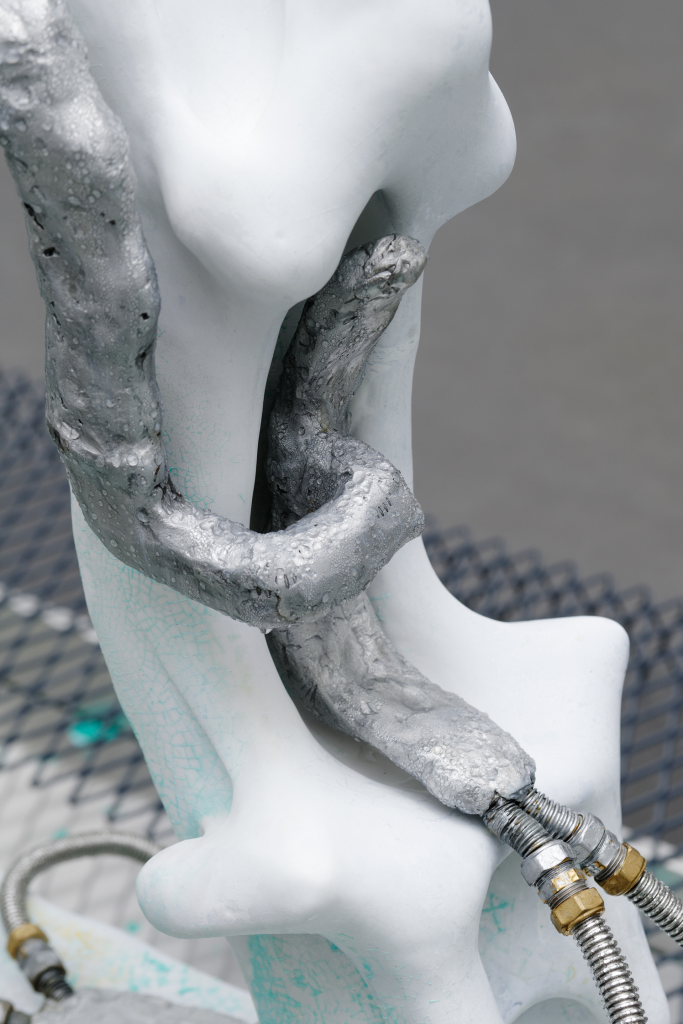
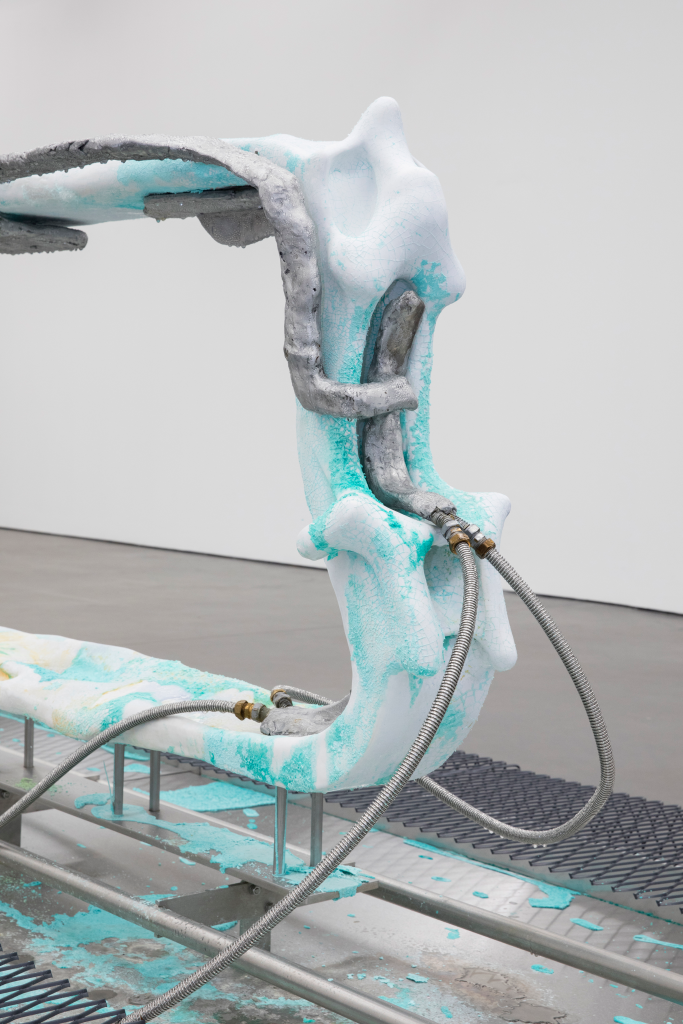
Ceramics, aluminum, epoxy, nickel sulphate, stainless steel, water cooler, pump. 640 cm x 210 cm x 130 cm
Photo credits: Franzi Mueller Schmidt. Courtesy: the artist and De Pont Museum, Tilburg
Isabelle Andriessen:
I think there are mainly two distinct ways in which time plays a crucial role within my work; on the one hand in which the works address human and non-human time scales and on the other hand in which the performative ability of the materials that I apply influence the way in which art is handled and perceived both in the private as well as the public domain.
One of my notions of time addresses loss, grief and finitude. I have a strong desire to create a space in which the viewer is confronted with a work that is only temporarily in a certain state, due to the fact that parts of the work will transform or disintegrate over time. The presence of death has always played a crucial role in the way I perceive life, I guess a force that is instilled with the fact that I want to understand where things go when they pass or die. Ever since I can remember I have had a strong urge to connect with this underworld, the dark side, to connect to those who are no longer with us. I guess it’s this desire that directed me to the research into darkness and decay – almost as if I want to prove to myself or others that nothing is ever lost. While simultaneously by becoming one with the continuing force of loss, I might be closest to death, to that dark and other side. It is this that offers me comfort, or a sense of closeness to that which is dearest to me that I have lost. I experience a deep sense of pain, truth and presence when I’m fully aware that it’ll only last for a short or temporal time – when I know that something is never mine to keep. In that way, my work is not only a portal to loss but also to love, a deep-rooted love or desire to keep something you cannot have.
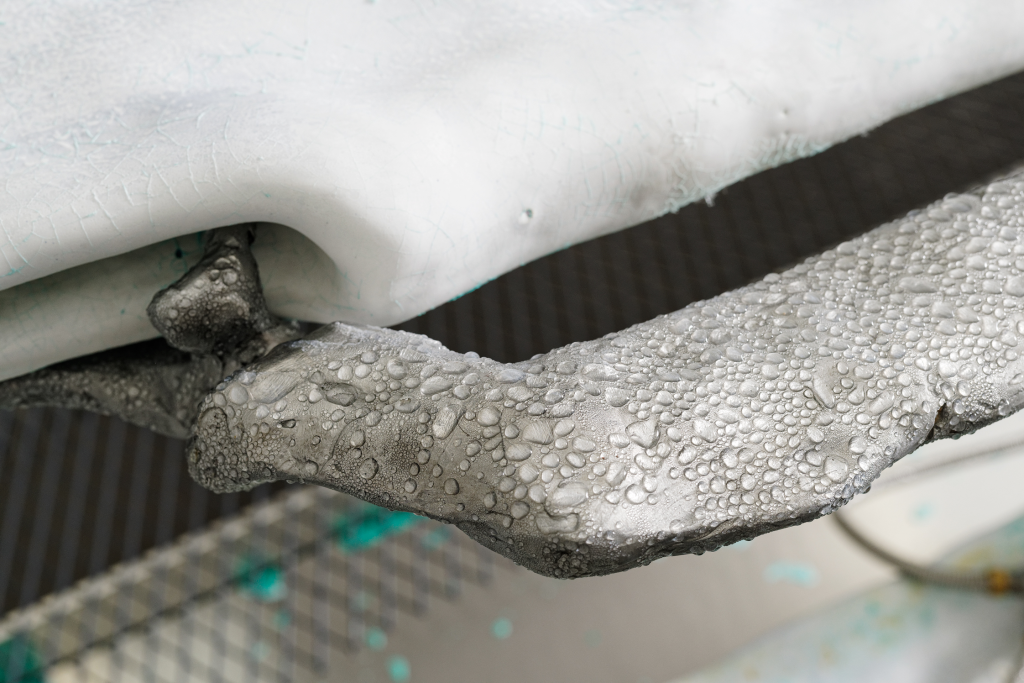
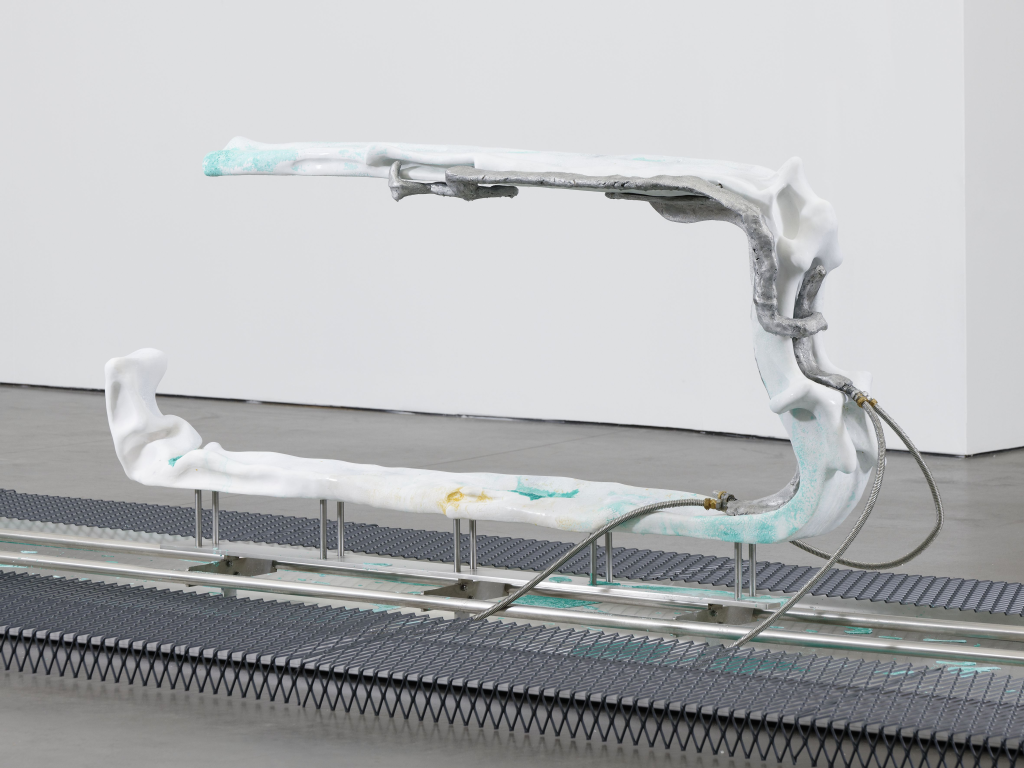
Ceramics, aluminum, epoxy, nickel sulphate, stainless steel, water cooler, pump. 640 cm x 210 cm x 130 cm
Photo credits: Franzi Mueller Schmidt. Courtesy: the artist and De Pont Museum, Tilburg
#
ÖÖÖ:
The scenarios such as “The Enchanters”, “Necrotic Core”, and “Cryo-rite” spontaneously lead us to zoom out our perspective to a grand macroscopic time scale, endeavoring to identify the scales at which these entities may exist. Meanwhile, part of ourselves remains rooted in the awed present, contemplating what happens before and after.
What are alternative approaches for viewing your work?
Isabelle Andriessen:
I aim to create space for loss or try to make it visible. When my works are on display, they are activated by these different processes at stake – it is this performance that automatically disintegrates the work, it’s instigating its own end and destruction while being on display. To see the work, it also sets this destruction in motion.
An important starting point of my work is the viewer’s experience of time within the given exhibition space. When my sculptures are acquired by a public collection, the focus shifts to conservation and the complex control museums exert over maintaining artworks. Whereas my artworks will continuously transform even when they are in a collection. I want to actively, almost like an activist, push and expand the framework that I think is currently limiting contemporary art displayed and collected within art institutions. My work is in dialogue with these hosting or commissioning art institutions and research ways in which the institutions can facilitate other ways to conserve and display contemporary and performance-based art.

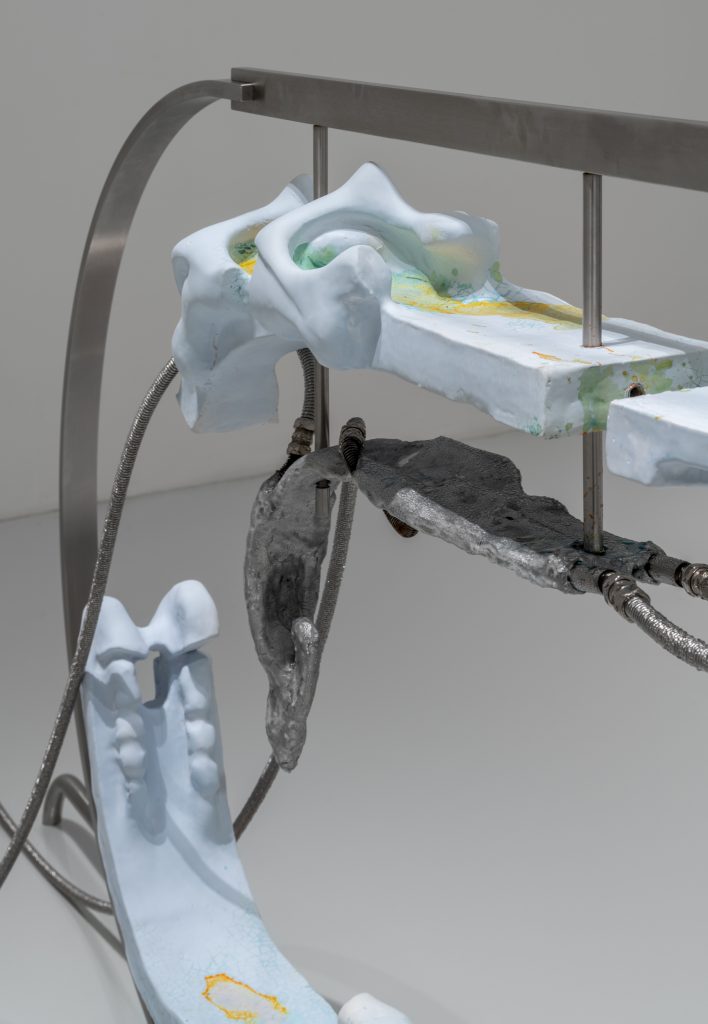
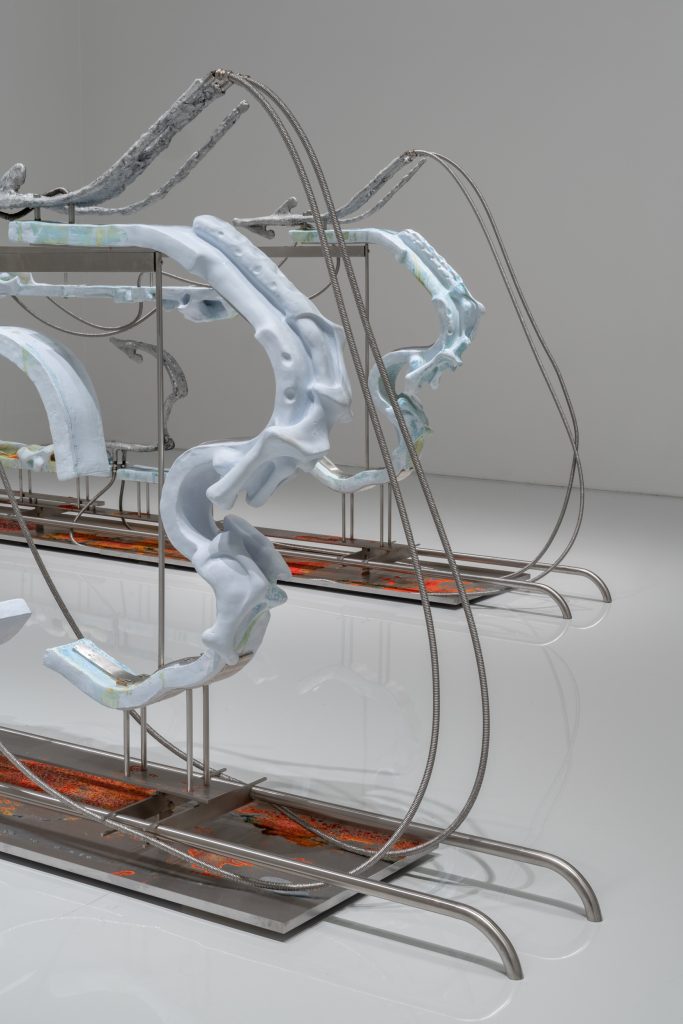
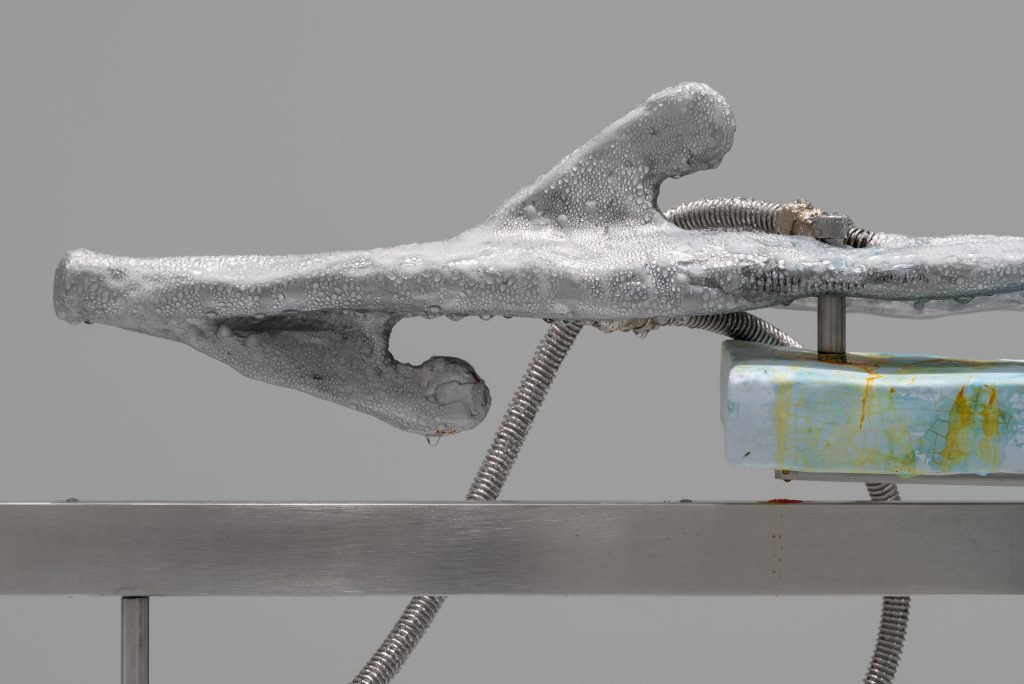
Ceramics, aluminum, epoxy, potassium hexacyanoferrate (III), stainless steel, water cooler, pump. 530 cm x 70 cm x 170 cm each
Photo credits: David Stjernholm. Courtesy: the artist and Moderna Museet, Stockholm
#
ÖÖÖ:
“I resonate more with the notion of an endless continuum of events. I believe there is apocalypse upon apocalypse, or catastrophe upon catastrophe — an inhospitable darkness that is also a fertile source for new flourishing entanglements.” You once responded to Natasha Hoare’s question about whether you have an apocalypse imagination. You perceive that, according to the law of conservation of mass, nothing truly disappears, substances are entangled in complex systems.
What are the ongoing transformative energies driving your artworks, including those operating at a non-substantive level?
Isabelle Andriessen:
I perceive my sculptures as actors in an opera or instruments in an orchestra; each of the different sculptural elements feeds one another or instigates action to one another. Meanwhile, they are also responding to the atmosphere they are placed in – in which elements like temperature, moisture, sunlight, and heat are continuously changing.
#
ÖÖÖ:
Akin to fungi or compound substances, various aggregations and extensions embody the continuation of life. However, our perspective may be limited by the notion of the “decay” phenomenon. How do the dynamics between “decay” and “life” function in your art approach?
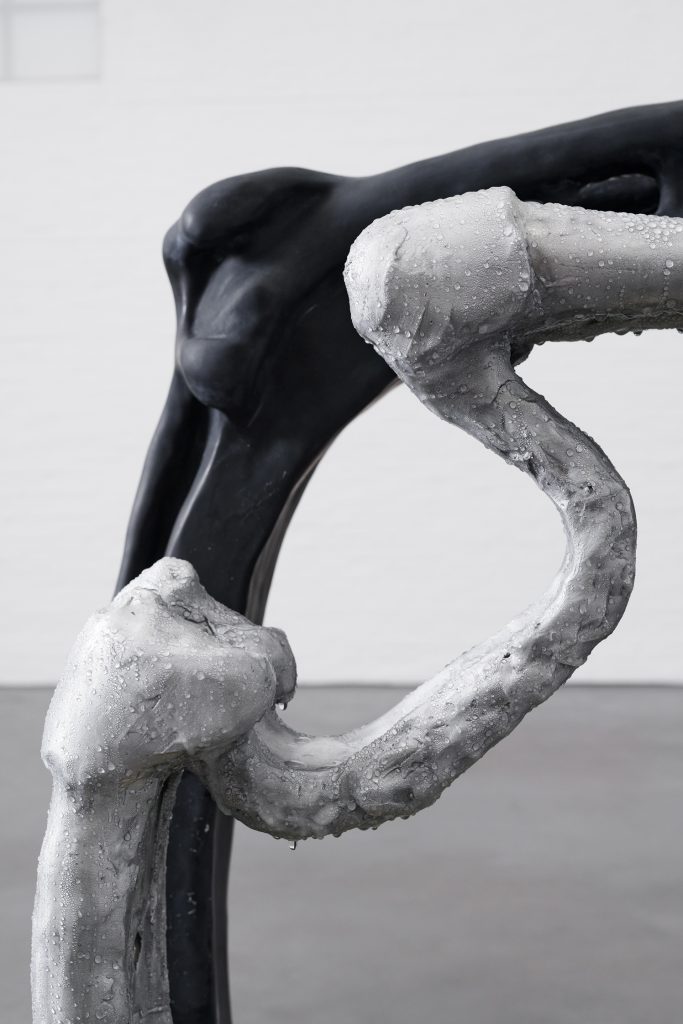
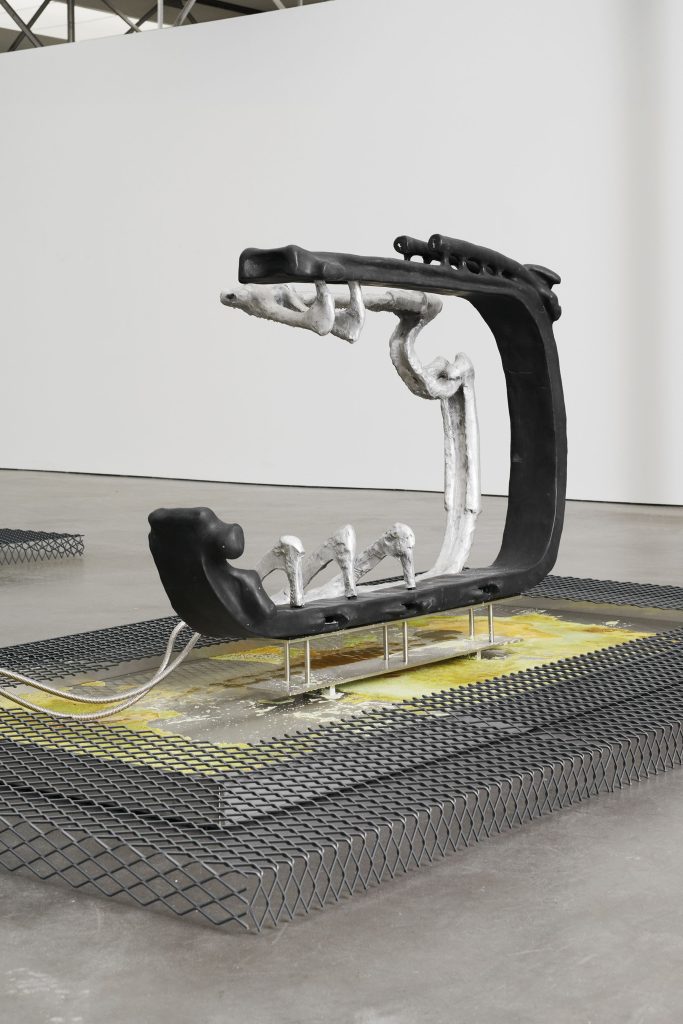
Ceramics, aluminum, epoxy, iron II sulphate, stainless steel, water cooler, pump. 380 cm x 210 cm x 160 cm each
Photo credits: Aurélien Mole. Courtesy: the artist and De Pont Museum, Tilburg
Isabelle Andriessen:
With my work I aim to address a world, attuned to death, thriving with new organs and sex, allowing for new entanglements are flourishing in a non-human world. I’m researching how to embed the unclear border between the uncanny and queerness in materials – from an active act of switching between familiar and unfamiliar. I solely execute and simulate that within synthetic materials, to reveal the darker agenda’s these materials encompass. Highlighting their ability to mummify, colonise and violate.
The material process unfold in phases choreographed over one or several exhibitions; Some of these slow material performances last a few months, while others continue to develop over years. They showcase the passage of time, troubling notions of permanence, posterity, and the primacies afforded the restoration and collection of art. Which in some perspective might resonate with similar dynamics to be found in behaviours of decay and the living materials that make up the world around us.
#
ÖÖÖ:
You “paint” with science, brilliantly imparting sculptures with a uniquely striking coloration. The liquid or sticky ooze often features vibrant hues of blue, green, yellow, and more—relating to quite specific phenomena in our natural environment yet still exuding a strong otherworldly aura. Have you encountered any impressive experiences while experimenting with colors through chemical and physical reactions?
Isabelle Andriessen:
These colors are incited by the ingredients themselves. The most exciting aspect of working with these ingredients is their unpredictable behavior. When I work with these chemical ingredients, I always end up with a result that I could not have foreseen beforehand. This also evokes another type of engagement and excitement, especially when I have the chance to revisit my shows after a few months, which almost always reveal very unique and unexpected changes. The same goes for when my works are being unboxed as they travel from exhibition to exhibition, to storage, and back to exhibition again over the years.
#
ÖÖÖ:
What subjects are you interested in integrating or expanding further?
Isabelle Andriessen:
I just installed one part of a diptych titled Ghouls, commissioned by Middelheimmuseum. Ghouls derives from the Arabic word ghūl. A ghoul is a demon-like being or monstrous humanoid, often associated with graveyards and the consumption of human flesh. The concept originated in pre-Islamic Arabian myths, culture and language. By extension, the word ghoul is also used in a derogatory sense to refer to a person who delights in the macabre or whose occupation directly involves death, such as a gravedigger or grave robber, luring around death sides or graves.
At the moment much of my time is dedicated researching the different aspects involved around the violence and horror that is expanding rapidly in different parts of the world, which I try to relate to, while it’s almost impossible to fathom. Which I believe is very urgent, as it is haunting and pressing.
Ghouls will be presented over two separate exhibitions, and the second part opening during a larger solo exhibition in early 2025. The work emphasizes darkness, violence, and horror contextualized by narratives around tunnel warfare, death, and the underworld. In doing so I research how to channel my urge to relate to charged and complex contemporary topics like war, human and non-human survival strategies (and its ruins), environmental disruption, and death.



Ceramics, aluminum, epoxy, potassium hexacyanoferrate (III), stainless steel, water cooler, pump
Photo credits: Franzi Mueller Schmidt. Courtesy: the artist and Middelheim museum, Antwerp
#
ÖÖÖ:
What specific elements and techniques are you currently researching for your upcoming projects, and how are you evolving your artistic language to enhance new modes of performativity and animation in your work?
Isabelle Andriessen:
Currently I’m working on a performance that can be best described as a requiem and a musical essay, instilled with scientific knowledge, ecological findings, material agency and historical events. Eventually this work will be performed live sometime by the end of this year and beginning of next year. I can’t give away much more yet, but I’m very excited since I’ve been dreaming about carving out on the production of this performance for quite some time.
When looking a bit more ahead in the future, I’m researching how to develop a series of sculptures that will create a continuous set of public performances, where the works undergo an impressive transition from one phase to another. These transitions will take place between a couple of hours to one day, throughout the exhibition and beyond. My ambition is to have the sculptures perform multiple distinct and scheduled transitions, stages, or acts, in which the works transit from one phase to another. These transitions will take place at a fixed moment or day which will be publicly announced like a performance or event. By performing, the sculptures are directed or conducted to be the performers themselves. It’s not necessarily meant as an event where the viewer is collected in a space for a certain amount of time, but over a few hours to a day, the viewer will be invited to witness this short-lived performative transition, to have a unique and time-based experience with the work.
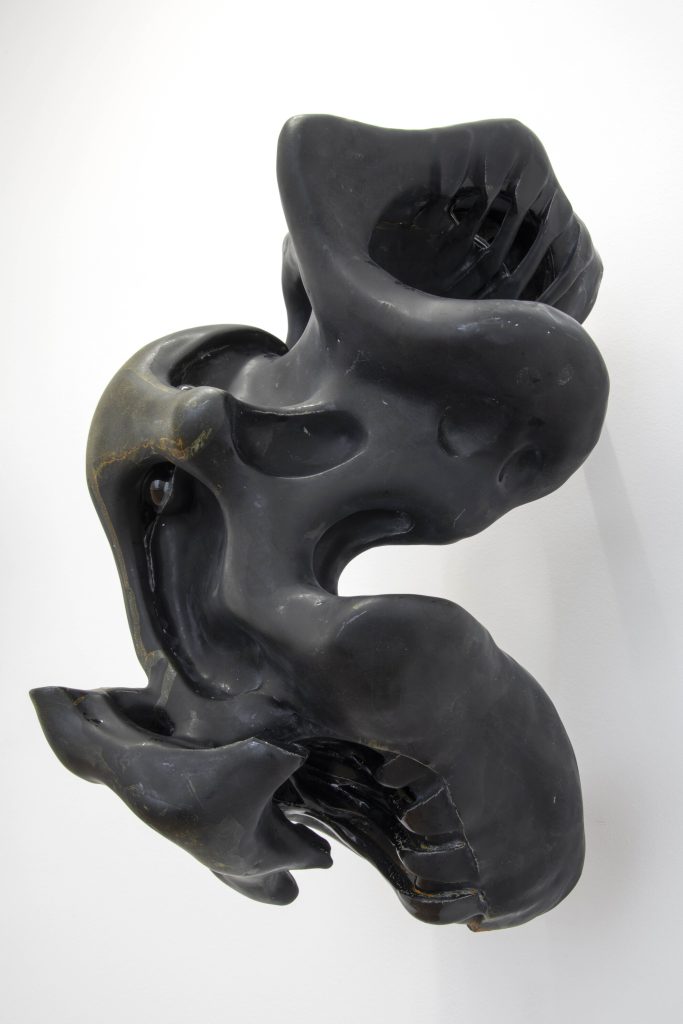
Ceramics, potassium hexacyanoferrate (III), stainless steel
Photo credits: Isabelle Arthuis. Courtesy: the artist
#
ÖÖÖ:
At the end of the interview, could you please share some of your recent favorite music or books with us? Thank you!
Isabelle Andriessen:
The artist that I currently listen to when I work are Zaliva-D, Chinese Experimental music from the 70’s, Richard H Krik, Burial and 33EMYBW. Currently I’m reading Parallel Minds by Lauri Tripaldi, The Hour of our Death by Philippe Aries, Death to Dust by Kenneth Iserson and Mummies, Cannibals and Vampires by Richard Sugg.
Artist Info
Isabelle Andriessen
ÖÖÖ is growing in primitive future.


